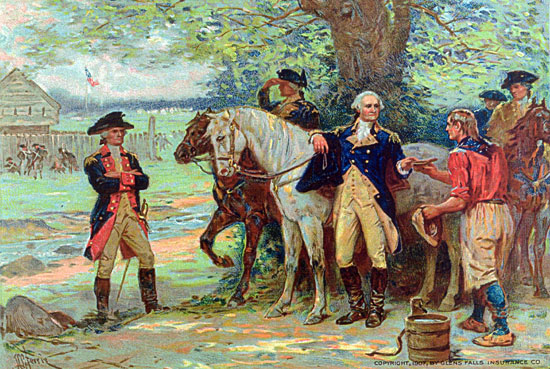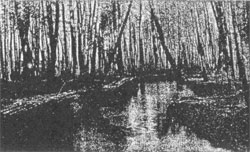| |


Half-Way Brook, Crandall Park, Glens Falls, N. Y. 1907. |
FOR No. 8 of the Glens Falls insurance Company's series of Local Historical
Calendars, this subject is chosen.
In July, 1783, Washington's headquarters were at Newburgh, N. Y. The
activities of the Revolution were pending peace negotiations. Tiring of
inactivity, Washington took a tour from the northern battlefields and fortifications of Saratoga,
Fort Edward, Fort William Henry (Lake George), Ticonderoga,
Crown Point, and intermediate points. Then from Schenectady he went up the Mohawk
Valley to Fort Stanwix.
Irving in his Life of Washington says, "Washington returned to Newburgh on the
5th day of August, after a tour of at least seven hundred and fifty miles, performed in
nineteen days, and for the most part on horseback."
Washington was accompanied by Governor Clinton, General Alexander Hamilton,
Colonels Humphreys and Fisk, and perhaps others. This party halted at Half-Way
Brook, at near the present entrance to Crandall Park, Glens Falls, N. Y., for refreshment,
and one Briggs, who was at work in a nearby field, brought pail and cup and supplied
water from the brook for their drinking.
The picture is an excellent reproduction of an oil painting by
Ferris representing the above incident. The painting is owned by the Glens Falls
Insurance Company.
Half-Way Brook is conspicuously notable in the bloody annals of the many years of
contest for the possession of the "Great Carry" – the overland break in the then all-water
way from New York to Quebec. It was strategic territory, and the holding of these few
miles between the then head of Hudson River navigation at Fort Edward and Lake George
was fraught with constant peril all through the Indian, French and Indian, French and
English wars, and the War of the Revolution. There were several fortifications along
these few miles, and Half-Way Brook was the more extensively fortified because of its
midway location, and was the scene of many cruel fightings.
(See Holden's "Half-Way Brook in History," Volume VI., New York State Historical
Association, 1906.)
The New York State Historical Association has placed a large cast bronze tablet on
a glacial boulder at the intersection of Glen Street and Glenwood Avenue, Glens Falls,
N. Y., as a Half-Way Brook marker as well as for Fort Amherst and the Seven Mile
Post. The tablet is inscribed as follows;

Half-Way Brook Historical Marker
Corner of Glen Street and Glenwood Avenue, Glens Falls, NY.
Placed by the New York State Historical Association. |
HALF-WAY BROOK
So called because midway between Forts Edward and William Henry. From 1755
to 1780 it was the scene of many bloody skirmishes, surprises and ambushes. Here the
French and Indians inflicted two horrible massacres, one in the summer of 1756 and the
other in July, 1758.
FORT AMHERST
A noted military post, midway between this marker and the brick yard. Its site was
known locally as "The Garrison Grounds." The location was used as a fortified camp,
1757-1758. The fort was built in 1759. It was occupied by the forces of Baron Riedesel
in the Burgoyne Campaign of 1777. It was burned in 1780 in the Carleton Raid at the
time of the Northern Invasion.
THE SEVEN MILE POST
Was a blockhouse with stockaded enclosure occupying the rise of ground north of
the Brook and west of the road from 1755 to Revolutionary times. During that period
it was one of the mast important halting places in North America.
Back to the Stories of the French & Indian and Revolutionary Wars. |


